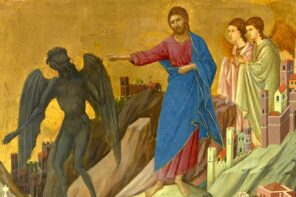Is American Hasidism in crisis? After successfully rebuilding its institutions after the war, Hasidism in America has flourished. And yet, its response to COVID and its newfound reactionary political populism, leads us to ask the question: is something changing in contemporary Hasidism that’s worth examining more closely?
Much has been written lately about the politicization of the Hasidic world in America, particularly its full-throttled support of Donald Trump. In fact, Hasidic voting patterns now closely resemble those of evangelical Christians. Scholars and pundits have weighed in on this surprising political activism in a community that usually keeps a low profile and focuses on its internal needs. And this activism has become even more visible as Hasidic communities have flouted health guidelines in the COVD crisis and made a public health issue into a political one. While the fact of these phenomena have been well documented, what are some of the underlying conditions that have contributed to a kind of “perfect storm” of populist reactionary Hasidic activism?
Part of what we’re witnessing in this new Hasidic populism is another stage of Hasidic Americanization in the wake of the loss of the last vestiges of European authority. The great Hasidic figures from Eastern Europe commanded intense devotion and respect from their communities, representing an authentic world destroyed in the Holocaust. Others emerged to take their place but it’s arguable that the weight of authority of these masters was not replicated in their American or Israeli born successors.
This isn’t to argue that these new rebbes haven’t commanded respect; they certainly have. It’s simply to point out that the force of their authority is diminished in comparison to those who arrived in America from prewar Europe. Eastern Europe was the fertile ground of Hasidic aristocracy. America, Mandate Palestine, and Israel, stood in its shadow. The loss of first-hand exposure to those halcyon years diminished Hasidism’s luster and authenticity. It continues, albeit in a different register.
If this is true, it’s worth considering how it contributes to a rise of the Hasidic populism that’s taken to the streets to express disdain for the government and its health mandates. It’s a complicated situation and is certainly the result of many factors. In one sense, this is a classic example of a popular revolution when individuals without much authority somehow evoke a rebellion against authority (think of Castro and Che in Cuba), be it religious or civil, by touching the nerve of a rapidly growing community in crisis coupled with a weakened stature of leadership.
The transformation of COVID from a health crisis to a political movement in the Hasidic world is a phenomenon that merits deeper study. When and why did this happen? Why and how did street protests against mask mandates and synagogue and park closings turn into Trump rallies in Hasidic Brooklyn? It’s true that Trump espouses conservative values that many Hasidim identify with, but so did Ronald Reagan and he didn’t enjoy such passionate support. And Reagan arguably did more for Hasidim than Trump ever did when, in 1984, he granted them “disadvantaged minority status” enabling them to apply for federal funding for businesses.
Whether, in fact, this speaks to a significant shift in Hasidism’s politicization or not remains to be seen. What I’m pointing to here is the rise of a populist mind-set where a rabble-rousing radio talk show host and Hasidic outsider like Heshy Tischler, who has no authoritative role in the community whatsoever, can attract the attention of young Hasidic boys and compel them to take to the streets.
One could view this as a positive manifestation of the growing autonomy of these communities and their increased involvement in public political life. And yet, as I will suggest below, an unreconstructed Hasidism will invariably—and, given theological considerations, understandably—be attracted to a reactionary political agenda and autocratic leadership.
The Americanization of Hasidism
Hasidism rose from the depths of Jewish traditional society in Eastern Europe during a tumultuous time. The Napoleonic Wars were changing the map of Europe, autocratic rule was slowly transforming into early stages of tolerance and later democracy. Emancipation may still have been decades away, but encroaching modernity from the West was making inroads into the traditional Jewish world, attracting some of its most talented youth.
In some way, Hasidism was both a rebellion against the internal autocracy of the rabbinic elite and the modernizing mind-set of the enlightenment (haskala). It made a play for both power and piety in a very unstable period. Among the challenges of a nascent Hasidic world was one of political alliances; in one case between Napoleon and the freedoms he promised, and in the other, Czar Alexander I and an autocracy that allowed Jewish enclaves to continue their traditional lives.
Similar debates made their way westward questioning whether emancipation was good for the Jews; that is, whether the modernization that accompanied the promise of freedom ultimately threatened the Jewish tradition. As told by Chaim Heilman in his Beit Rebbe, Shnuer Zalman of Liady offered a cogent assessment of the wager: if Napoleon wins, Jews will be materially successful but will suffer spiritually, and if Alexander wins, Jews will be materially impoverished but will spiritually flourish. Throughout its history, Hasidism has lived in the balance of that wager. It arguably filters through Hasidism’s entire negotiation with modernity. Perhaps until now.
America presented another way to understand this bargain. What we may be witnessing today is another layer of the complex process of the Americanization of Hasidism. The first stage may have been propagated by Eastern European Hasidic immigrants, many of whom were survivors of the Holocaust, in their initial reconstruction of Hasidic dynasties in America. Schneerson’s (Lubavitch) advocacy of a moment of silence in public school (supporting Jerry Falwell), his campaign to erect Hanukkah Menorahs in public squares, and his Noahide Law campaign to gentiles, all illustrate his deep belief in America.
And Teitelbaum’s attempt to secure public funding for special education in the yeshivot in the Satmar enclave, Kiryas Joel, speaks to the extent he too understood America as holding potential for his own religious vision. The Satmar enclave of Kiryas Joel isn’t a replica of something that existed in prewar Europe. It was, as David Myers and Naomi Stolzenberg write in their upcoming book, Teitelbaum’s American fantasy; an American shtetl.
In the street protests and general political activism in present day Hasidism we may be witnessing yet another iteration of Hasidism’s developing Americanism. While Hasidim have always supported political candidates and voted in relatively high numbers, most of the advocacy was primarily transactional; they supported candidates they thought could maximize their resources. In 2020, impromptu pro-Trump rallies in Flatbush and Boro Park, a pair of Brooklyn neighborhoods with high numbers of Orthodox Jews, illustrates a new kind of political populism seldom seen in communities that often prefer to stay out of the spotlight.
The question as to why Hasidim overwhelmingly supported an immoral, autocratic, and reactionary candidate with such verve and vigor is multivalent. One reading may have to do with a lopsided equation of integration. That is, on the one hand Hasidim are becoming politicized as a result of their developing Americanism, which values public political expression. At the same time, however, they haven’t revised their general worldview, which was built on earlier political realities, a theology and religious ideology founded on chosenness, and historic feelings of exclusion and resentment.
The “us vs. them” mentality that grew over time and the theology that informed traditional Jewish teaching in large part followed suit. In many ways the binary of “friend vs. enemy” plays into the Trump vision of America. Traditional Jews, like the Ultra-Orthodox Hasidim, have historically been attracted to strong autocratic leaders who shared their binary view of the world. In this sense, their support of Trump is predictable
The challenge of emancipation, or the “liberal social contract” with the Jews in Europe, required Jews to revise those ideological principles to become fully a part of larger society. Non-Orthodox Judaisms, Jewish secularisms, and to some extent Neo- and Modern Orthodoxy engaged this challenge in different ways. But American democracy demanded an even stronger revision.
American rabbi Mordecai Kaplan argued that chosenness simply could not survive American democracy intact. One cannot easily be full members of a democratic society and maintain a theologically exceptionalist status. He was right, until he was wrong. By the 1950s, sociologists talked of the “death of Orthodoxy” in America while Hasidism was just beginning to rebuild in this new land of tolerance—what Rabbi Schneerson called a “medina shel hesed” (a land of kindness). Whether and how Orthodoxy could bear the weight of American integrationism was an open question.
What the sociologists of the 1950s could not have predicted was the rise of the counter-culture that would re-frame America’s conformism into a multitude of expressions of difference, pluralism, and later, multiculturalism. This would not only save Orthodoxy but enable Hasidism to enter the public square with minimal ideological and theological revisions. Schneerson saw this in the 1960s more than any other American Jewish religious leader and his movement flourished, riding the wave of multiculturalism. One of the byproducts of the multicultural turn was the ability of more traditional Jewish communities, Hasidim among them, to maintain strict observance and retain their ideological and theological commitments while increasingly becoming a part of American society. By the 1960s, acculturation was no longer a prerequisite for integration. Hasidim entered the public square without having to pay much of a theological or ideological price. The “liberal social contract” no longer carried the weight it once did.
The problem, however, is that Hasidim entered the public square with their old-world chauvinistic and xenophobic inclinations intact and residual fears of the left stemming from the days when the left meant socialism in Europe and when Russia used communism as a tool to attack and demolish religion. Given Jews’ complicated relationship with race, and African Americans in particular, this fear easily transformed into a belief that the progressive left, in part in the BLM movement, was inherently anti-religious, and antisemitic. Interestingly, the antisemitism of the right seemed less threatening, perhaps more familiar, than the antisemitism of the left. Trump subtly exonerating the marchers at Charlottesville seemed less problematic than Linda Sarsour’s anti-Zionism. Even though they weren’t Zionists, “Jews will not replace us” seemed less threatening to the Hasidim than “Israel is a colonialist state.”
Another paradoxical twist in this story is that the antisemitism of the left today in America is largely targeting Zionism, which the Hasidim largely don’t support either, albeit for very different reasons. Thus, what’s emerged is a kind of Hasidic anti-Zionist pro-Israelism; tacit support for Israel as an act of tribal fidelity rather than any form of Zionism. Ask a Hasidic Jew touting Trump’s moving the US Embassy to Jerusalem whether he is a “Zionist” and he will think you’re crazy. Anti-Zionism has been part of the very fabric of Hasidic Judaism for a long time, even now in muted form. But somehow without abandoning that, they found a way to support Israel and deem left-wing anti-Zionism a form of antisemitism, while their form of anti-Zionism is protecting Judaism.
The Trumpization of Hasidic Jewry should not be surprising and it can be thought of as the byproduct of multiculturalism’s enabling. When Hasidic groups can enter the public square without compromising their theological and ideological commitments—that is, without a “liberal social contract”—they can easily be attracted to right-wing reactionary movements. They will support the Czar over Napoleon.
In earlier times, as Shneur Zalman of Liady suggested, they had to compromise their material wealth for the sake of spiritual survival. In America that’s no longer necessary. They can have both and in addition they can partner with a segment of the majority (white evangelicals) that has ostensibly found its own tacit acceptance of the Jews through its own version of Zionism. Just as Hasidim can be anti-Zionist and pro-Israel, evangelicals can be antisemitic and pro-Israel. It’s not very provocative to say that when Hasidic ideology, founded on the kabbalistic tradition, becomes politicized, it can easily support a kind of autocracy—as long as they are the beneficiaries.
On this reading, the origin of Hasidic Trumpism may be Schneerson himself. It was Schneerson who believed Hasidic Jews could enter the public square without sacrificing any of their ideological positions. He couldn’t have predicted Trump but he enabled the Hasidic support of a candidate not merely as Jews, but as “Americans,” while holding onto views that reflect a Jewish experience of the old world.
Schneerson’s success is undeniable, but we may be seeing the dark side of that success in Hasidic Trumpism. Chabad has been adept at presenting its Jewish vision in the form of a sweetened Judaism to non-religious Jews and to the world more generally. But the support of a political figure who expresses a different form of chauvinism is telling in regards to how the deep-seated ideological core of Chabad, and Hasidism more generally, remains operational.





